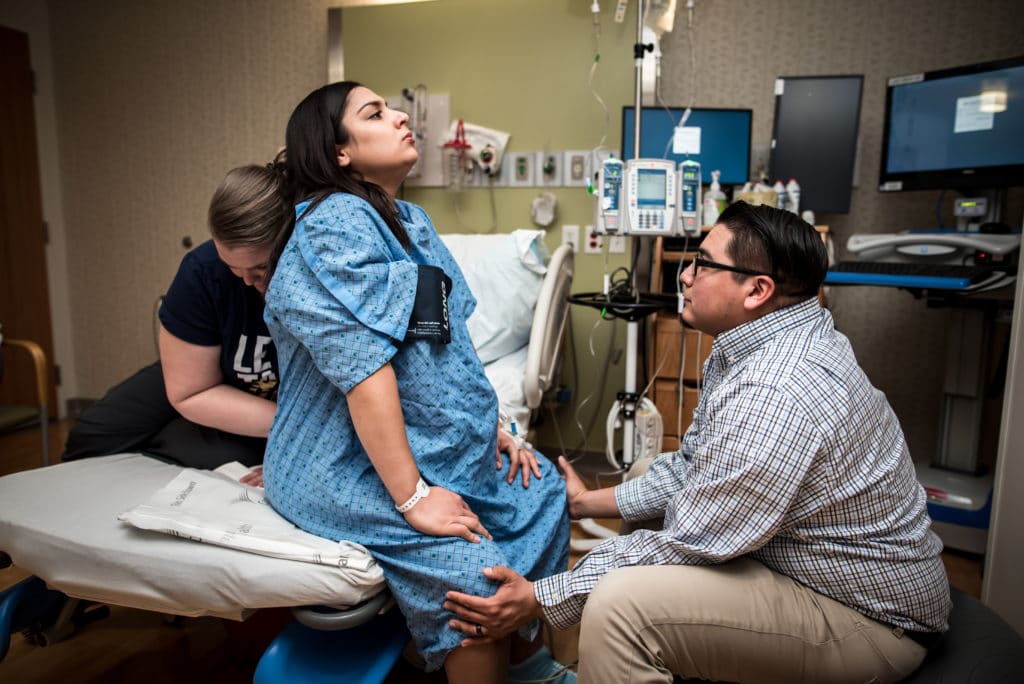Have you been told you may have a larger than average baby? One of the leading concerns with carrying a macrosomic baby is shoulder dystocia.
A large baby is not the only risk factor for shoulder dystocia, and there may be things one can do to help prevent it. Crazy enough, most cases occur in birthing people with normal or average-sized babies.
A health care provider may have concerns about shoulder dystocia happening again if it happened in a past pregnancy, or if there are other risk factors. They may even suggest a C-section instead of attempting a vaginal delivery.
This article is all about the risks of shoulder dystocia, options parents have if this happens, and what it may look like during delivery.
Originally published June 27, 2018, this article was updated and republished on April 20, 2020.
What is shoulder dystocia?

Shoulder dystocia occurs when a baby’s head has been born, but the shoulders get stuck or lodged in the birthing parent’s pelvis, and the baby is having a hard time making it past the pubic bone.
Like a transverse baby, a baby with shoulder dystocia may not be able to exit the birth canal without some kind of assistance. It can make it difficult to avoid the need for a C-section.
Shoulder dystocia is considered an emergency and may cause a provider a lot of anxiety during delivery. Getting a baby out and keeping the birthing person safe is their main priority. If shoulder dystocia happens, the birthing parent may need assistance in getting the baby out in a timely manner to avoid risks to both the parent and the baby.
According to Evidence Based Birth, babies who weigh more than 8 lbs 13 oz have a 6% higher chance of shoulder dystocia than babies who are smaller than that. Even then, a large majority of babies who are smaller can still have shoulder dystocia.
Shoulder dystocia risk factors
Even though it may not happen often, it is important to know more about it in the event it does happen. A provider may end up calling in a team of helpers to assist in getting the baby out. It can affect not only the baby but the birthing parent if it occurs.
The birthing parent may see the following complications from shoulder dystocia:
- Receiving a larger than normal (4th degree) tear to the perineal area
- Hemorrhage
- Possible damage to the pelvic floor
- Abdominal bruising or damage from being pressed from the outside to help assist the delivery of the baby
- Uterine Rupture
- Bladder atony, (damage to the bladder causing it to be hard to urinate)
A newborn may have the following complications from shoulder dystocia:
- Brachial plexus palsy
- Very rare but possible the newborn may receive brian damage due to the lack of oxygen received during delivery
- The newborn may obtain broken bones, specifically the clavicle and humerus
- Fetal death (RARE)
Shoulder dystocia usually happens unexpectedly. Therefore, it is typically hard to predict. Sometimes a provider may be able to tell that it is coming when a baby is taking longer than expected to come out after the head has been born.
A provider may consider you at higher risk for shoulder dystocia if the following occurs:
- The most recent growth ultrasound shows the baby may be measuring larger than 9 lbs
- Labor was induced
- Shoulder dystocia happened with previous deliveries
- Long labor
- BMI of the birthing person is 30 or more
- There is a vacuum or forceps assisted operative vaginal delivery
As mentioned above, most of the time shoulder dystocia is unable to be predicted. However, a provider may offer an early induction if an ultrasound showed a “big baby,” if the birthing person has diabetes, or for VBAC with gestational diabetes.
It is important to note that even if these are suspected or are present, an early induction does not guarantee the elimination of the risk of shoulder dystocia.
There is also a chance that the provider may suggest skipping an induction, and going straight to a Cesarean or not offer a TOLAC (Trial of labor after Cesarean) as an option. Cesareans also have risks to the birthing person and baby. In addition, C-sections also carry risks for future pregnancies and deliveries.
ACOG (American College of Obstetricians and Gynecologist) states that a scheduled Cesarean “may” be considered if a baby has an estimated birth weight of 11 lbs or higher.
Birth injuries caused by shoulder dystocia

When shoulder dystocia happens, it is crucial for the provider to get the baby out safely and quickly. A provider will oftentimes be able to determine if they will be able to deliver the baby vaginally with support. If they do not feel like it is possible to do so safely, they may suggest an emergency Cesarean.
Brachial plexus palsy
One of the most common injuries is brachial plexus palsy. This is when the nerves in the brachial plexus are damaged during the delivery. These nerves control the ability to move and control the muscles in the arm. It’s caused by the stretching of the baby that is performed when the baby gets stuck and needs to be born quickly with support. It tends to get better over time but can range from very mild to severe depending on how complex the delivery is.
Brachial plexus injuries may be caused by multiple factors related to the physiology of labor and delivery. No published clinical or experimental data exists to support the contention that the presence of persistent neonatal brachial plexus palsy could only be caused by the application of excessive force by the birth attendant.
Potential brain damage (rare)
Brain damage caused by shoulder dystocia is very rare. It may be referred to as birth asphyxia. This occurs when the second stage of labor is prolonged and the cord or baby receives a lack of oxygen to the brain, causing birth asphyxia.
Fractured bones
It is possible for the baby to receive a broken clavicle (collarbone) or humerus (the long bone in the upper arm) during delivery. Both of these breaks should be confirmed with images by the medical staff.
Sometimes it is hard for a provider to recognize that a baby’s bones have been broken. These are typically quick recoveries, but need to be stabilized so the newborn can recover. These injuries can often be avoided with quick recognition that the shoulders are stuck.
One may ask if there is a risk of it happening again in the future. According to shoulderdystociainfo.com, the chances of having a shoulder dystocia recur with future pregnancies is approx 10-15%.
Is a scheduled C-section recommended?
Because there is really no way to tell if a birthing parent will have a baby with shoulder dystocia, there is no true medical reason to offer a C-section.
Despite the use of ultrasound to attempt to estimate fetal weights, there is currently no way for obstetricians to accurately determine which babies will be macrosomic or will experience shoulder dystocia at delivery. New work on shoulder dystocia prediction algorithms may change this existing limitation in obstetric practice.
Although a family centered Cesarean delivery may sound like it removes a lot of the risks and complications of shoulder dystocia, it still comes with a certain amount of risk. When a parent undergoes a Cesarean, there are risks to the parent as well as the baby.
Risks a Cesarean brings to birthing parent:
- Surgical injury to the bladder or other organs ie: laceration to the bladder
- Infection due to surgery
- Extra amount of blood loss and possible Hemorrhage
- Blood clots
- Inflammation or infection to the uterus
- RARE: Amniotic fluid embolism (when the amniotic fluid enters the birthing parents blood)
- Complications for future pregnancies such as placenta previa or accreta, infertility, risk of uterine rupture
- Poor reaction to the medication given during the surgery
- Hysterectomy
- Death to the birthing parent
Risks to a baby due to Cesarean section:
- Breathing issues
- Asthma developing in the child
- A small risk of the fetus being cut before being born
- Lungs being undeveloped due to baby being born too early
- Low APGAR Scores
If all babies who were detected to be “large” also known as macrosomic had to be born by C-section, the Cesarean rate would increase dramatically. A large majority of babies who have shoulder dystocia are normal or averaged sized babies.
It is mentioned in the ACOG Bulletin Number 178 in May of 2017:
“It was calculated that 3,695 cesarean deliveries would be required to prevent one permanent injury.”
Diagnosing shoulder dystocia

Although it is difficult to accurately predict shoulder dystocia, providers do have some indicators to look for. If the birthing parent has had an ultrasound indicating a large baby, or is diabetic, they may be considered by the provider to be at risk. They also may show concern if the previous pregnancy ended in shoulder dystocia.
Ultrasound is one of the ways a provider may try to indicate if a baby is going to have shoulder dystocia. Unfortunately, ultrasounds are only 100% accurate half of the time. We have had many clients be told that their babies are going to be on the larger side. Then when it came down to delivery, they were considered very average or normal-sized babies.
“Turtle sign” during delivery
When the birthing parent is in labor, providers will be ready, and watching for certain signs.
During the pushing process, the baby makes a rocking motion coming down with each push and then after will go up a little. When the next push begins, the baby will come down even more, and eventually, do what’s called “crowning.” At the crowning stage, the baby typically comes out pretty quickly.
Once the head is delivered, if there is a pause in movement, also known as the “turtle sign,” a provider may recognize that shoulder dystocia is happening. They may request the birthing parent to get in a different position, request extra help, or quickly explain that an assisted delivery or Cesarean is needed.
Shoulder dystocia maneuvers
So what does it look like when shoulder dystocia has been recognized?
The birthing parent may be asked to stop pushing. There are a few things a provider may suggest to help give more room in the pelvis, using an acronym called HELPERR. The provider would go through these techniques to help the birthing person deliver the baby.
- H: Help. The provider will call for help.
- E: Evaluate. The provider will evaluate if the birthing person would benefit from an episiotomy. This is where the provider cuts the premium to allow for more space quickly. Shoulder dystocia likely is not released with an episiotomy so the provider may suggest the McRoberts Maneuver next.
- L: Legs (McRoberts Maneuver). The birthing person is asked to pull the knees back where the thighs are touching the belly, pulling the pelvis up to the sky to create more room and allowing the provider and staff to assist the birth of the baby.
- P: Suprapubic pressure. Another provider places pressure over the baby’s shoulder from the outside, pressing downward while the provider on the other end continues downward traction.
- E: Enter Maneuvers (internal rotation) or also known as Zavanelli maneuver. A provider will try and rotate the baby into a better position, creating more room for the baby to fit under the pubic bone. This can be difficult to perform. Sometimes a provider will have to push a baby back up into the pelvis to accomplish this.
- R: Remove the posterior arm. The provider reaching in and helping the posterior arm be delivered allows the baby to drop down. This is done in a sweeping like motion by going inside the pelvis and gently pulling the arm and shoulder out all the way to the elbow. This motion raises the risk of a broken clavicle or humerus.
- R: Roll the patient AKA Gaskins maneuver. This is done by flipping the birthing parent over on all fours. Doing this simply may create space and allow the baby to come down, in addition to using gravity and opening up the sacrum/pubic area. If a birthing parent was at home, this may be a technique their skilled provider would try first.
In the event that none of these options are successful, the birthing parent may need to have a Cesarean section. It is important to discuss the actions that a provider would take in the event of shoulder dystocia. Every provider has their own training and comfortability.
FAQ
People often ask the following questions. In conclusion, we’d like to briefly touch on the following:
How is shoulder dystocia treated?
Shoulder dystocia is treated as an Emergency. Because it can happen suddenly and unexpectedly, it needs to be treated on a case-by-case basis.
What causes shoulder dystocia?
Although it is unknown what causes it or when it will happen, the following reasons may increase the risk of shoulder dystocia: The size of a baby, induction, a long birth, as well as diabetes.
What are the risks of shoulder dystocia?
Studies have shown that up to 1.5% of births end with shoulder dystocia. When it does happen, it can be scary and the risks of the fetus and birthing parent need to be reviewed. These risks include damage to the parent’s pelvic floor, abdomen, and bladder. For the baby, there is risk of nerve and brain damage, or breaking of the humerus or clavicle.
Can shoulder dystocia be predicted?
The simple answer is NO. Although ultrasounds are able to help us predict the size of a baby, they are not completely accurate or able to determine the best mode of delivery.
Educating yourself and discussing shoulder dystocia with your healthcare provider
If you or someone you know is being told that there may be a risk of shoulder dystocia, it is important to review all of the data and evidence being given in your particular situation.
Have an educated discussion with your provider on what their typical care plan looks like and what actions they would take or suggest leading up to birth. Ask the provider their comfort level on assisting in a shoulder dystocia situation. A large baby is not an indication that a Cesarean section is needed or the best plan of care.
In addition to a conversation with a provider, we can help you with some steps to create the most room for a baby to fit out of the pelvis in our article, Delivering a Large Baby Vaginally.
You can also listen to episode 8 on our podcast. Allie tells her story where she delivered a 10 lb VBAC babe and we talk more about shoulder dystocia.














 How to Turn a Transverse Baby (and Avoid a C-Section)
How to Turn a Transverse Baby (and Avoid a C-Section)